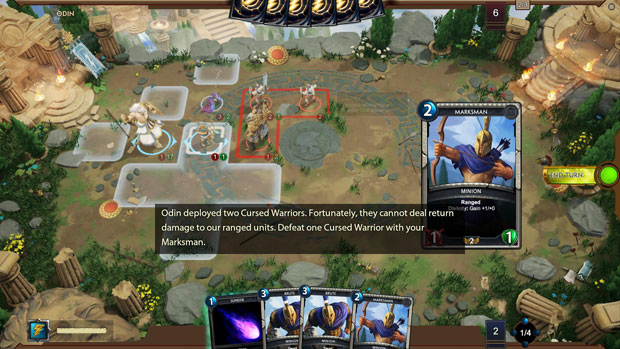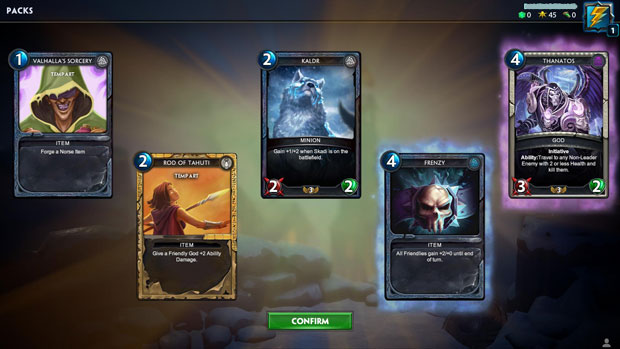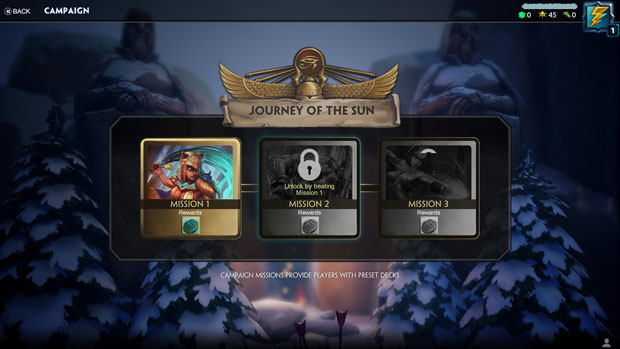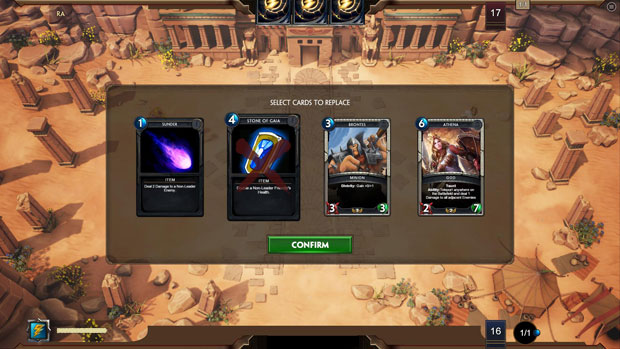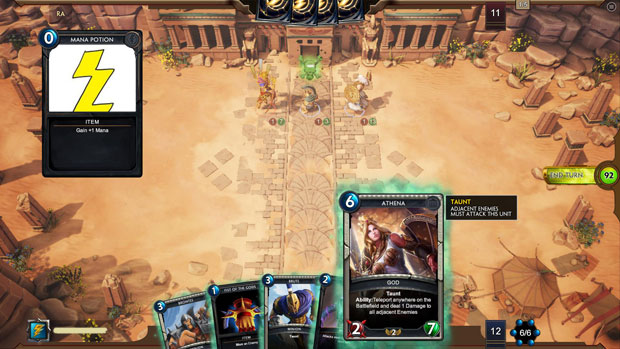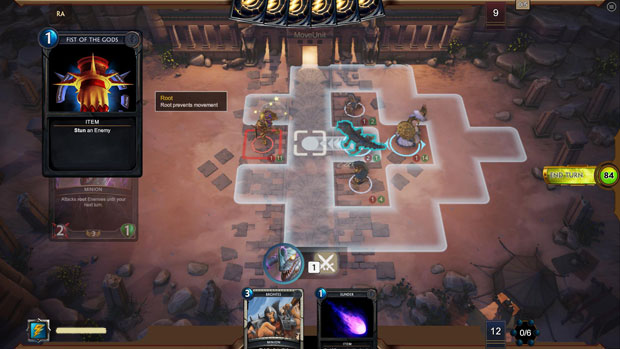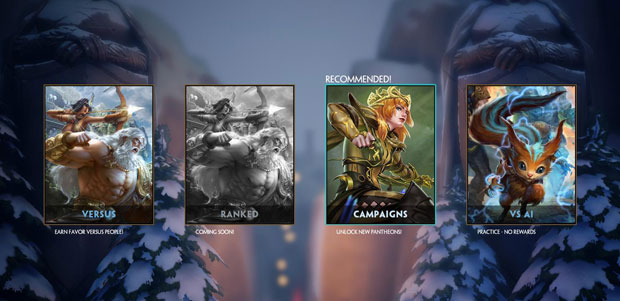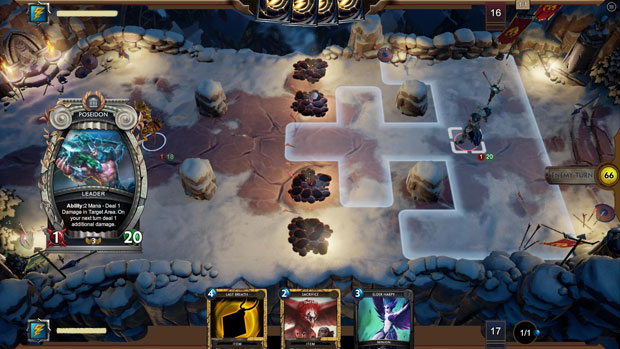Smite Tactics strategy card game puts gods on a grid
Hands on with Hi-Rez's Duelyst competitor
While out at Hi-Rez Expo 2017 I spent a bit of time with the studio's turn-based strategy card game, Smite Tactics [official site]. I've also been tinkering around with it since I came home – a couple of PvP games here, a campaign mission there… I feel like I've played enough to give you an overview of what it is and how it's different from other games in that genre like Duelyst, but it's also in that really rough-and-ready state that betrays its closed beta status. It's very much a work in progress, but let's have a look at how it's shaping up.
So first up let's look at what Tactics actually is. There's a card-collection and deck building aspect you'll likely be familiar with if you've spent time online with Hearthstone or offline with Magic: The Gathering (to pick two big names out of the air). Then there's the miniatures-on-a-grid battle side of things which has roots in turn based strategy gaming like Final Fantasy Tactics.
You build decks around a leader character card which takes the form of a god from one of the Smite pantheons. As you'd probably expect the rest of the cards consist of spells, minions and other Smite characters. You can pick from pantheon specific cards and a neutral pool of cards.
You play cards from your hand to cast spells or to spawn units onto the battlefield and you can also use your turn to move the units around or to attack and perform other actions. Cards and some other abilities have a mana cost which you pay from a mana pool which increases as the game progresses. The aim in the main PvP mode is to defeat your opponent's leader before they can kill yours.
There have been a bunch of Duelyst comparisons in relation to the game, which is understandable, but the big thing Tactics does differently is that each of the god characters has an active ability which they can deploy on the battlefield.
To pick an example, the leader god, Ra, can be played as a regular attack unit on your turn, or you can spend two points of mana and restore one point of health to every friendly unit in a selected area. As part of the rest of the deck you could have the card which lets you play Sobek as a unit. Sobek is also a god so he has an active ability too. You can use his regular attack to inflict one point of damage on a target or you could use his active ability to charge forward and throw an enemy up to three tiles behind him dealing 2 damage.
These abilities are themed around how the gods work in Smite, the MOBA, so players from that game will probably feel at home with this new iteration. It might take a bit of getting used to or building up game memory if not though.
So that's the basic flavour of Tactics, but beyond that it feels very early days. The user interface, particularly can be a bit of a conundrum as the team figure out elements and build on the core experience. There's also a lot of temporary and placeholder art, cards which might go through changes, deckbuilding information that's not yet in place, pantheons to be added and further campaigns to be planned out.
To dig a little deeper I chatted with Scott Lussier, the project lead for Tactics, about his plans for the game.
The roots of Tactics, he tells me, go back to mid 2015 where he and the game's executive producer, Scott Zier, were pondering turn-based strategy ideas in relation to Smite. It was more of a general conversation based on a mutual love of the X-Wing Miniatures tabletop game and Final Fantasy Tactics than a game dev brainstorming session. But a while later Lussier came back to Zier with a pitch which would, after a lot of paper prototyping, become Smite Tactics.
"Even if you don't come from Smite the main thing we want to do is, we have these gods," says Lussier. "They're way more powerful than anything else because they're gods, so they have to stand out from minions and they have to stand out from items."
That's where the active abilities come in.
The mention of X-Wing makes me wonder whether Lussier was ever tempted to go for a less grid-based battlefield on which to play. X-Wing is all about moving your ships around a space where a millimeter one way or another can make a difference to a shot. Grids are far simpler, but they can also lead to weird things like ranged units not having a true cone-shaped damage radius because an arrow fired at an angle would technically be travelling, for example, three squares along and one up instead of four units of distance in a straight line.
Lussier points out that the grid system is simply a better fit for PC and console gaming in this instance. I think it's certainly easier to understand and not feel overwhelmed by. It also fits the kind of Hearthstoney pick up and play, short match style they seem to be aiming for.
The leader gods for the current pantheons are Odin and Freya for Norse, Ra and Isis for Egyptian and Zeus and Poseidon for Greek. I'm wondering how those were picked given there are so many gods and any of them could have made for a leader role. Lussier tells me that Odin, Ra and Zeus were the most obvious choices from each of the respective pantheons but the second of each pair was more of a question.
"When we were looking at Norse as a whole we could do Thor but really when you think of the Vikings and everything else women were very prominent in their battles. We were like, Freya is the Valkyrie so we should totally make her a leader. Isis is the same kind of a thing in Egyptian and for Greek this is the part which sucks because we only have two of them but I was like, Poseidon and Zeus - the brothers."
Poor old Hades, Zeus and Poseidon's other brother, gets short-changed in this two leader per pantheon set up. Or, as Lussier puts it, "I feel kind of bad that I kind of shafted my man, Hades!"
So once you have these decks you need to figure out how to use them. At the moment the pantheons have basic trends. Norse has an "armies of minions" thing going on, Greek has a mix of tanky and spell-based/god-spawn based effects (Divinity effects) and Egyptian is more about buffs, translating minions into effects and crowd control.
But beyond that the deck-builder is very bare bones. One of the more obvious tools on the list to be added is information about your deck's mana curve. If you don't play these games much a mana curve is where you map out the number of cards you have for each mana cost in your deck to see what it looks like. If the curve is U-shaped it means you have a lot of low cost cards, a lot of high cost cards and not much in the middle. If it's more of a flat line it means you have roughly equal numbers of cards for all the different mana costs.
Mana curves are important because they give you an easy-to-read overview of your deck. If you have a lot of high cost cards you might struggle at the beginning of the game when your mana pool is really low so you would then go through the deck card by card and check for ways to guard against being beaten early. If you have a lot of low cost cards and nothing expensive you'd want to check that you still had ways to deal with beefy, expensive units the opponent might play later in the game. It gets a lot more complex than that, but this should at least explain the importance of mana curve tools in card games.
There's also likely to be some way of quickly seeing how many minions, how many spells and how many gods a given deck contains just in case you do that thing of accidentally building an all-spells deck which I have DEFINITELY never done.
Lussier explains the aim at the moment is to work towards a deck-building wizard. The wizard would guide you through a deck-building process so beginners could feel out what you're supposed to do by picking cards with some guidance. There would also, ideally, be some way to introduce people to different types of strategy, for example a spell-based deck for Ra where the wizard walks you through some options. This is all for the future, though so I'll be interested to see which options come to pass.
In terms of things like the dangers of netlisting or solved-problem card drafts – where instead of there being a million viable decks people can figure out for themselves there's a go-to list you download from the internet if you want to play competitively – the answers are more general. Listening to feedback from the community about whether anything is unbalanced is one, keeping an eye on statistics from the game is another, playing it as much as possible themselves is a third.
Lussier also stresses that although he's the lead on Tactics, that doesn't mean he's not also asking other people on the team for advice. "There's not a single design that I put out there that I don't ask at least one person from every single department 'Hey, this is what I'm thinking, let me know if this is a good idea or not.'"
At this point there are the three pantheons I mentioned earlier and the team are working on adding the Chinese pantheon soon. Beyond changing the deck-building options, different pantheons also mean new maps to play on. That's because each pantheon has an associated special environment tile which you only find on those maps. For example, one has bushes where you can conceal units and another has fire tiles which damage a unit standing there at the end of their turn. Lussier's dream on that front is that Tactics ends up in a situation where you can be watching a competitive match, see a player veto a particular map and know a bit more about how they're intending to play as a result.
After Chinese Lussier's team will turn to either the Mayan or the Roman deities. It'll likely be the Romans: "Realistically we'll probably do Roman just because when you look at mass appeal, who doesn't know the Roman gods?"
Tactics might even get ahead of Smite in terms of adding gods to the roster, although how that would work and whether the card abilities could influence MOBA skill sets is far too much of an unknown at this point.
On that point, a lot of the cards are marked as having temporary art and I guess they may diverge a bit from their source material but currently the game draws a lot from the Smite art. That means representations are skewed in a similar way to Smite - lots of bikinis on the goddesses while monstrous gods and humanoid gods get more variation.
The last thing we chat about is the campaign side of things. That's the game's PvE mode, or at least a player versus AI challenge. At the moment it's as bare bones as you'd expect while the developers tinker with the mechanics and cards of the game but the intention is to produce a higher level experience almost like a story mode with dialogue between games, padding out the characters and deepening the experience as you unlock new pantheons.
"The one thing we're definitely going to do is start looking at ways of setting up units already on the board and you have to be very cerebral about how you beat it," adds Lussier. "People love puzzles. I love puzzles.
"Inside the campaigns we can break the rules of the traditional game. If our normal objective is to defeat the enemy leader, in the campaign we might say you have to be the first team to destroy five pots." You'd then need to figure that out, working out different playstyles or placements of units in accordance with these new objectives.
For the moment the game will stay on the Hi-Rez launcher, but when it shifts to open beta it's like to be added to Steam as well as console distribution platforms in order to grow the player base. You can buy access if you fancy with the Founder's Pack at the moment. There are a lot of rough edges at the moment though so I'm going to get Brendy to spend some time with it (he seemed the best candidate given his affection for similar games) to see whether he recommends it in its current form!

